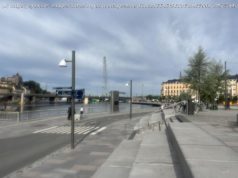News reports suggested that bones discovered in a Vatican-owned building could be tied to one of Italy’s most enduring cold cases.
ROME — In June 1983, Emanuela Orlandi, the 15-year-old daughter of a Vatican employee, vanished on her way home from a music lesson. In the intervening 35 years, Emanuela’s disappearance has been one of Italy’s most intriguing cold cases.
So much so that the mere discovery on Monday of human bones in a building in Rome belonging to the Vatican sparked a media frenzy, with front-page speculation that her remains had finally been found. The bones had not even been analyzed to determine whether they were those of a male or female.
The Vatican released a short statement late Tuesday saying only that bones had been found during the renovation of a building next to the Holy See’s Embassy to Italy, and that Rome’s chief prosecutor, Giuseppe Pignatone, had asked police experts to determine the “age, sex, and date of death” of the bones.
Clues in the case are tantalizing but scanty. Shortly after Emanuela vanished, Vatican officials received an anonymous call from ostensible kidnappers who promised to free her upon the release of Mehmet Ali Agca, the Turkish gunman who tried to kill Pope John Paul II in 1981. (After nearly three decades in Italian and Turkish prisons, Mr. Agca was released in 2010). Over the years, investigators have examined possible links to Bulgarian agents, the Sicilian Mafia, the K. G. B. and even the C. I. A.
After the Vatican announced that bones had been found, reports in Italian news outlets said that the Rev. Piero Vergari, the only prelate investigated in Emanuela’s disappearance, had once worked at the Vatican’s embassy to Italy, known as the Nunziatura. That was enough to lure numerous journalists to the purported scene of the purported crime on Wednesday morning.
Father Vergari had come under scrutiny because of his association with Enrico De Pedis, once the boss of Rome’s most notorious crime gang, whom he had met in his role as a prison chaplain. Mr. De Pedis was gunned down in 1990, and Father Vergari allowed his family to bury him in the basilica of Sant’Apollinare, a church in Rome near where Emanuela was last seen.
Father Vergari was never charged in the case.
In 2008, a former lover of Mr. De Pedis said that he had organized Ms. Orlandi’s kidnapping at the behest of an American archbishop, Paul C. Marcinkus, the former president of the Vatican Bank, who was linked to a major Italian banking scandal in the 1980s. Archbishop Marcinkus died in 2006.
In 2012, the police exhumed Mr. De Pedis’s grave, and bones found in a nearby ossuary were tested to see whether they were Emanuela’s. They were not.
New theories on the girl’s fate emerge with regularity.
Last year, an Italian journalist published a five-page, typewritten document that was stolen from an armored cabinet inside the Vatican suggesting that Holy See officials may have been directly involved in Emanuela’s disappearance and that she might still be alive. The Vatican said that the document, which suggested that the Vatican had paid for the girl’s expenses for years after she vanished, was “false and ridiculous.”
On Wednesday, the Vatican and lawyers for Emanuela’s family tried to tamp down some of the speculation prompted by the discovery of the bones.
A Vatican spokesman said Father Vergari had never worked at the embassy. Instead, he worked at the Segnatura Apostolica, the Catholic Church’s highest judicial authority.
Laura Sgro, a lawyer for the Orlandi family, said she and the family were “speechless” at the media frenzy. “We have no idea why the association with Emanuela was made,” Ms. Sgro said in a telephone interview.
“We’re still asking ourselves why you’d find some bones and immediately assume they were Emanuela’s,” she added.






